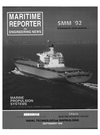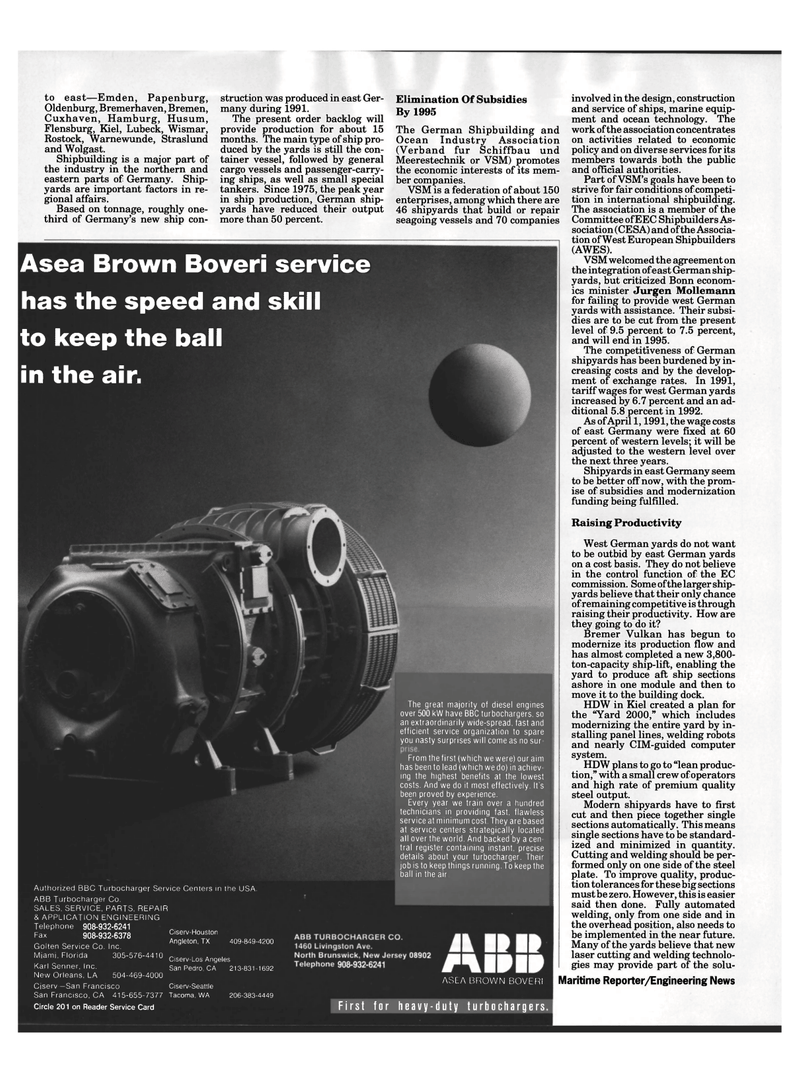
Page 60: of Maritime Reporter Magazine (September 1992)
Read this page in Pdf, Flash or Html5 edition of September 1992 Maritime Reporter Magazine
to east—Emden, Papenburg,
Oldenburg, Bremerhaven, Bremen,
Cuxhaven, Hamburg, Husum,
Flensburg, Kiel, Lubeck, Wismar,
Rostock, Warnewunde, Straslund and Wolgast.
Shipbuilding is a major part of the industry in the northern and eastern parts of Germany. Ship- yards are important factors in re- gional affairs.
Based on tonnage, roughly one- third of Germany's new ship con- struction was produced in east Ger- many during 1991.
The present order backlog will provide production for about 15 months. The main type of ship pro- duced by the yards is still the con- tainer vessel, followed by general cargo vessels and passenger-carry- ing ships, as well as small special tankers. Since 1975, the peak year in ship production, German ship- yards have reduced their output more than 50 percent.
Elimination Of Subsidies
By 1995
The German Shipbuilding and
Ocean Industry Association (Verband fur Schiffbau und
Meerestechnik or VSM) promotes the economic interests of its mem- ber companies.
VSM is a federation of about 150 enterprises, among which there are 46 shipyards that build or repair seagoing vessels and 70 companies
Asea Brown Boveri service has the speed and skill to keep the ball in the air.
The great majority of diesel engines over 500 kW have BBC turbochargers, so an extraordinarily wide-spread, fast and efficient service organization to spare you nasty surprises will come as no sur
From the first (which we were) our aim has been to lead (which we do) in achiev ing the highest benefits at the lowest costs. And we do it most effectively. It's been proved by experience.
Every year we train over a hundred technicians in providing fast, flawless service at minimum cost. They are based at service centers strategically located all over the world. And backed by a cen tral register containing instant, precise details about your turbocharger. Their job is to keep things running. To keep the ball in the air
ASEA BROWN BOVERI involved in the design, construction and service of ships, marine equip- ment and ocean technology. The work of the association concentrates on activities related to economic policy and on diverse services for its members towards both the public and official authorities.
Part of VSM's goals have been to strive for fair conditions of competi- tion in international shipbuilding.
The association is a member of the
Committee of EEC Shipbuilders As- sociation (CESA) and of the Associa- tion of West European Shipbuilders (AWES).
VSM welcomed the agreement on the integration of east German ship- yards, but criticized Bonn econom- ics minister Jurgen Mollemann for failing to provide west German yards with assistance. Their subsi- dies are to be cut from the present level of 9.5 percent to 7.5 percent, and will end in 1995.
The competitiveness of German shipyards has been burdened by in- creasing costs and by the develop- ment of exchange rates. In 1991, tariff wages for west German yards increased by 6.7 percent and an ad- ditional 5.8 percent in 1992.
As of April 1,1991, the wage costs of east Germany were fixed at 60 percent of western levels; it will be adjusted to the western level over the next three years.
Shipyards in east Germany seem to be better off now, with the prom- ise of subsidies and modernization funding being fulfilled.
Raising Productivity
West German yards do not want to be outbid by east German yards on a cost basis. They do not believe in the control function of the EC commission. Some of the larger ship- yards believe that their only chance of remaining competitive is through raising their productivity. How are they going to do it?
Bremer Vulkan has begun to modernize its production flow and has almost completed a new 3,800- ton-capacity ship-lift, enabling the yard to produce aft ship sections ashore in one module and then to move it to the building dock.
HDW in Kiel created a plan for the "Yard 2000," which includes modernizing the entire yard by in- stalling panel lines, welding robots and nearly CIM-guided computer system.
HDW plans to go to "lean produc- tion," with a small crew of operators and high rate of premium quality steel output.
Modern shipyards have to first cut and then piece together single sections automatically. This means single sections have to be standard- ized and minimized in quantity.
Cutting and welding should be per- formed only on one side of the steel plate. To improve quality, produc- tion tolerances for these big sections must be zero. However, this is easier said then done. Fully automated welding, only from one side and in the overhead position, also needs to be implemented in the near future.
Many of the yards believe that new laser cutting and welding technolo- gies may provide part of the solu- 62 Maritime Reporter/Engineering News
First for heavy-duty turbochargers
Ciserv-Houston
Angleton, TX 409-849-4200
Authorized BBC Turbocharger Service Centers in the USA.
ABB Turbocharger Co.
SALES, SERVICE, PARTS, REPAIR & APPLICATION ENGINEERING
Telephone 908-932-6241
Fax 908-932-6378
Golten Service Co. Inc.
Miami, Florida 305-576-4410
Karl Senner, Inc.
New Orleans, LA 504-469-4000
Ciserv—San Francisco
San Francisco, CA 415-655-7377
Circle 201 on Reader Service Card
Ciserv-Los Angeles
San Pedro, CA 213-831-1692
Ciserv-Seattle
Tacoma, WA 206-383-4449

 59
59

 61
61
